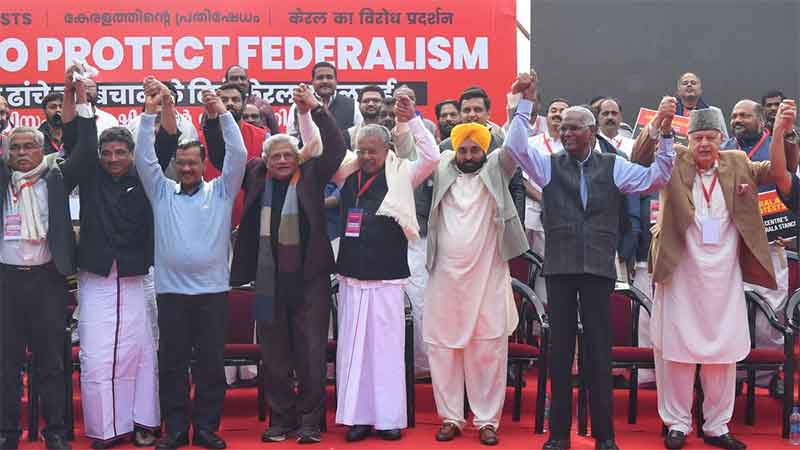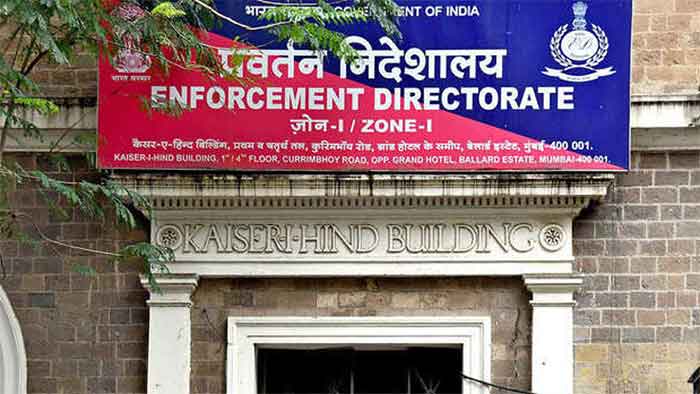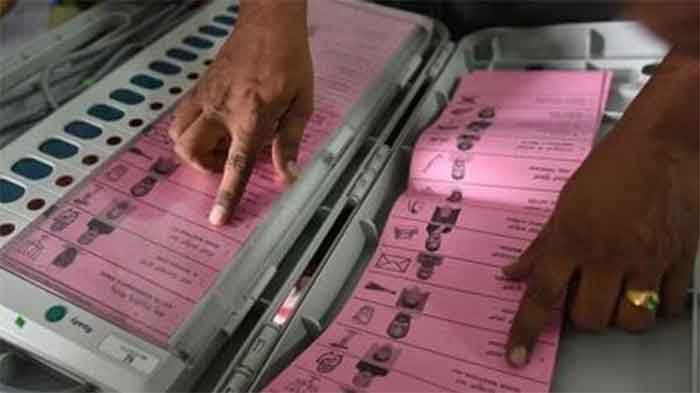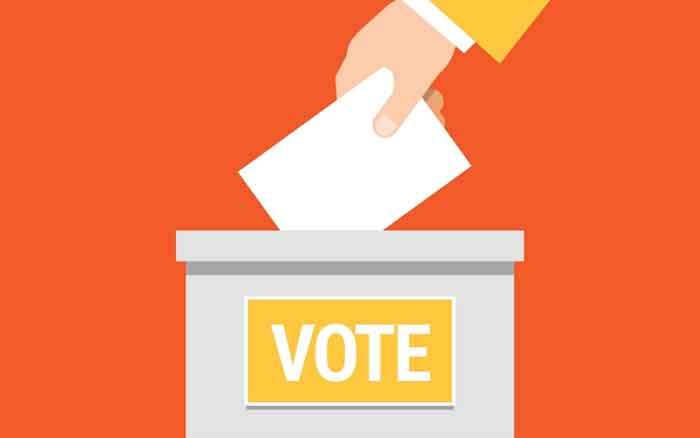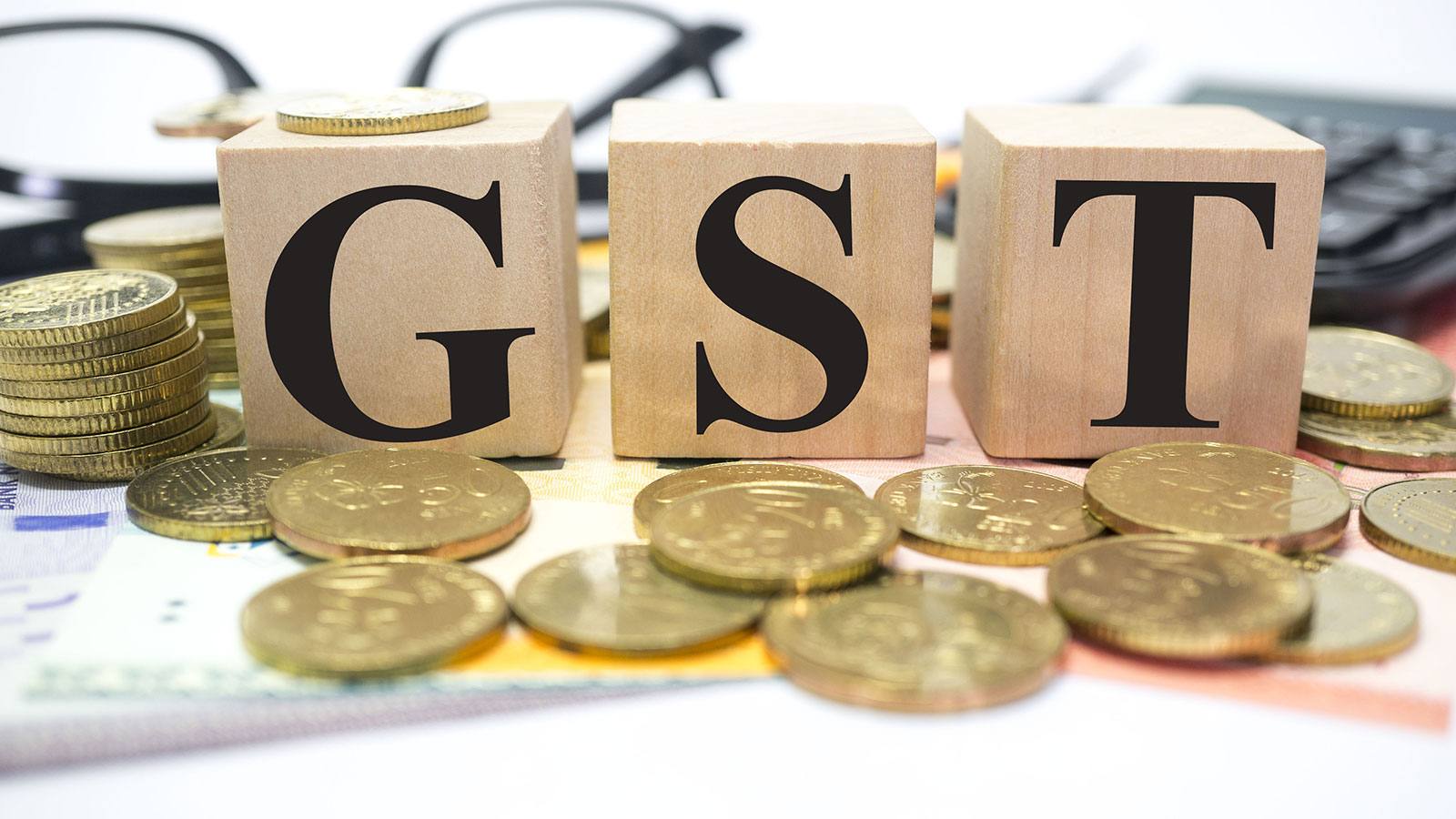
State governments are perplexed by the long delay in convening the quarterly Goods and Services Tax council meeting. The council has not met over the last four-and-a-half months whereas the Procedure and Conduct of Business Regulations of the GST Council stipulates that it has to meet once every quarter of a financial year. The West Bengal government shot off a letter but so far, the Union government hasn’t even acknowledged it. Earlier, the State governments’ demand for extending the GST compensation package – for shortage in tax collection up to a certain level – was also dealt with in the same manner. The States can do nothing about it. In letter the GST regime may be an equal table for the States and the Union but in spirit it tilts heavily towards the latter.
Meanwhile the Union Minister for Petroleum, Hardeep S. Puri, took a jibe at State governments urging them to bring petrol and diesel under the GST regime knowing well that they won’t dare to. It is a cash cow for both the Union and State governments and hence was kept beyond the GST system right from its inception. But that too has become a point of contention.
The GST regime has become the battleground between the States and the Union government for some time. The aftermath of the last GST council meeting held in June was an indication. The council had increased tax on some items and as soon as the announcement came out all hell broke loose. The Union government and the Opposition accused each other for the decision. Parliament was stalled for days.
The Opposition came out all guns blazing, but soon had to run for cover. It was a clear win for the Union Government because nobody could effectively explain why the decisions of tax hike were unanimous, either on the Parliament floor or in the newsroom debates. All the States, including the Opposition-ruled ones, had voted in favor of lifting the earlier tax exemption for the packeted but not branded rice, wheat and milk products. There were tax hikes on some other items also which too got passed unanimously. In fact, for some time GST council members – Union finance minister and the finance ministers of the States – have been meeting with the sole agenda to hike tax rates. Licking its wounds, the Opposition was waiting for the next council meeting, which now seems to be postponed indefinitely. The turnaround was intentional since it happened after the date- first week of August- and the venue- Madurai, Tamil Nadu- for the meeting was fixed.
How the honeymoon ended
The GST regime came into force on July 1 , 2017; just eight months after the infamous demonetisation. The maverick act had choked the cash flow in the country for some time. The economy almost came to a grinding halt with the unorganised sector, where 93% of the workforce belong to, taking most of the brunt. GDP growth crashed by 2.47% within 6 months – from 8.58% in the third quarter of FY 17 to 6.11% in the first quarter of FY 18. Still, the Opposition was almost unanimous in supporting the Modi government’s next biggest intervention in the economy.
With careful theatrics by setting its inauguration at midnight – reminiscent of the country’s first constituent assembly session of August 14, 1947 – and a blitzkrieg of media commentary, which poised the event as the nation’s big leap into a mighty economic force, we began our tryst with a new tax regime. Every single leader of the Opposition was present at the Parliament central hall. Nobody wanted to miss out. The mood was euphoric.
The hopes and promises were multi-level. On the tax collection front, a huge spike was predicted as most of the economic activities will come voluntarily under the tax scanner due to the peculiarity of the new system. Second, exponential economic growth because taxes will be comparatively less. Third, by doing away with double taxation – taxing the same product more than once- and entry tax at the State level, ease of doing business will improve. The Goods and Services Tax was dubbed Good and Simple Tax.
Still, it was a hard sell for the Union finance minister Arun Jaitley. The GST needed a constitutional amendment which required a majority of the total membership in both Lok Sabha and Rajya Sabha and also a majority of not less than two-thirds of the members of each House present and voting. The BJP didn’t had enough numbers in the Rajya Sabha .The Opposition was doing everything they could to stall the government’s agenda with their majority in the Upper House. Nevertheless the major Opposition party, the Congress, was among the first to fall in line. Then the rest followed. Jaitley lured them with the promise of better State finances – a minimum 14 percent tax growth every year for each State. If that doesn’t happen, the Union government will make good the shortage for a period of 5 years. A special fund called the GST compensation fund was also set up for the purpose. At that time, 11 states were ruled by the Opposition parties. The Indian economy was slowing down from the remarkable growth of average 8% a decade ago and the States’ coffers were in bad shape. GST seemed to be the panacea for all the income worries.
But the early days of GST were marked with utter confusion. To begin with there was a lot of paperwork to be done at least every week if not every day! Nobody knew exactly how to file forms. Errors, mismatches and strikes in returns filed were common. So was the understanding of new terms like input credit. The tax system had changed into a chain of tax filings where an entity getting tax benefit depends on its supplier depositing the tax collected from it. It was a brilliant self-regulatory mechanism but chaotic too by its very design. People who had never filed a tax return found themselves outside the new supply chain and their business dwindled. Some could get in and some could not, depending on their ability to adapt.
In the beginning itself tax collection crashed. It was expected as every new path-breaking system needs time to adjust. Month after month of poor tax revenue also didn’t dampen the supporters’ spirits. Months gave way to years without any drastic increase in tax collection. Still the hopes were high. Then, the pandemic arrived. In the financial year 2020-21 Indian economy went into a negative growth of more than 6%, the highest among the major economies. The country is still in the recovery path.
Covid-induced economic slowdown drilled large holes in the treasury for both the States and the Union. Even before that, the rate of tax growth was falling. The new GST regime couldn’t reverse the trend. Tax revenue as percentage to GSDP (Gross State Domestic Product) of States in general came down from 7.7% in FY 2014 to 6.38% in FY 2021. Telangana was the only exception. The States were piggybacking on the GST compensation package. But that was for 5 years and it ended last June. A financial crisis that can even paralyze some State governments is looming. Moreover the financial pains of the pandemic are not over. A large part of the population still needs hand-holding and they expect State governments to do so. Alarmed by the imminent danger, States turned to the Union government but were cold-shouldered. Not only in extending the GST compensation but also in the fiscal freedom of States to borrow .
Fiscal federalism my foot!
Things are no better for the Union government either. They have been managing it by increasing revenue from duties and cesses on goods and services which are non-shareable with the States. A recent paper by the National Institute of Public Finance and Policy, a think-tank under the finance ministry, admits to it.
For example in the 2021 Union Budget, a new cess – the Agriculture Infrastructure and Development Cess (AIDC) – was introduced to be levied on 29 products including gold, silver, petrol, and diesel. Around Rs.30,000 crore will be collected annually which will be utilised for building agriculture infrastructure. But there will be no price rise, assured the finance minister, as the other taxes on such products – basic excise duty and special additional excise duty – will be lowered to offset the new charge. If the total money collected doesn’t change, why introduce new tax heads? By changing the heads in which money is collected, the Union government siphoned off Rs.30,000 crore annually from the Consolidated Fund whose proceeds are to be divided with the States. States protested but in vain. It’s allowed by the Constitution.
The Finance Commission (FC) – constituted for every five years – decides the ratio in which the revenue collected under the Consolidated Fund is to be shared between the Union and the States. The latest, the 15th Financial Commission, fixed the States share at 41%. The 14th FC also made a similar recommendation fixing the divisible pool at 42%. But the actual figures are very low, thanks to the new system of circumventing the age old tax sharing system. Budget figures confirm the fact. In the 2022-23 Budget, the Union government pegged the tax revenue at Rs. 27.57 lakh crore and share of States at Rs. 8.16 lakh crore. This puts the States’ share at around 30%!
Over time, especially in the last decade, the Union government has been consistently increasing the share of cesses and special excise duty on commodities. In FY 2019-20, the Finance Act was amended to raise the limit up to which the government can raise special excise duty on petrol and diesel; petrol to Rs. 18 per litre and diesel to Rs. 12. And then in the next year a new cess (AIDC) of Rs. 2.50 per litre on petrol and Rs. 4 on diesel along with an equal reduction in basic excise duty and special additional excise duty to escape the people’s wrath, which we discussed earlier. Sometimes the Union government even reduces the taxes in the divisible pool disproportionately winning people’s accolades. For example, gold and silver bars were levied 2.5% agricultural cess (AIDC) while its Customs duty was reduced by 5%. The prices fell. Sates’ loss and Union’s gain!
Can States do something?
Given the hue and cry on the last tax hike, the GST council may not dare to do it again, at least for some time. Meanwhile, the recent hikes will not suffice to tide over the crisis. India, as diverse as a continent, may not have a single magic pill for the crisis. States individually had a chance given their own strengths and challenges. They could review the tax slabs and make changes accordingly. But in the post-GST era, that is not possible. The States have surrendered their taxation rights to the GST council.
The 50:50 proportion of sharing the GST collection is also ridiculous. The States have surrendered Value Added Tax (VAT), their single biggest tax lever that collected almost two-thirds of all their revenue. The loss of the Union government was limited to around one-fourth. This is because, unlike VAT which was levied on final sales, the Union government’s indirect taxes were on production (central excise, for example) which had a less tax base. Even though it is true that the new and robust sources of revenue for the Union government from the services sector have become shareable, so far it has not been enough to make up for the States’ loss. Tax revenues as a proportion of GSDP fell sharply for all. Even for industrially advanced States such as Maharashtra, Gujarat, Karnataka and Tamil Nadu. Karnataka leads the list with a fall of 4.6% within the last eight years, according to a recent study by Gulati Institute for Finance and Taxation (GIFT), Kerala.
Earlier, States had tax brackets as high as 40-45 % while the highest one in GST is only 28%. After sharing with the Union government, States’ share will be just 14%. Further, within months after the inception of the GST, in the 23rd council meeting, 178 out of 229 items in the 28% bracket were brought to the 18% bracket. Former finance minister of Kerala Dr. T.M. Thomas Isaac remembers it as “a competitive reduction. Some States will propose tax reduction for some items and everybody will agree. Then another State will pick up some other item. Nobody wanted to be known as the one who opposed tax reduction”. The meeting was in the middle of Gujarat election campaign. Moreover, the high expectations of the new tax system were still there. And there is always the compensation package for the States if things go south. But did that reduce the prices? In most of the cases it didn’t, according to a working paper by GIFT.
So far it was a happy-go-lucky ride, with the Union government compensating the gap in revenue growth up to 14%. Except for a few small States – Arunachal Pradesh, Nagaland, Manipur, Mizoram- all others claimed compensation. Reasons can be the initial hiccups in the new tax system and economic slowdown but it is also true that no State had a 14 percent revenue growth in the last 10 years. In fact, the average tax growth of states together was below 10 percent in the last decade. So the compensation package was very tempting. The State governments were ready to surrender anything. Mercifully, the Union asked only for taxation rights.
The compensation package didn’t arise out of the magnanimity of the Union government. It was paid from a special fund created out of charging cess on various items ranging from pan masala to motor vehicles. But during pandemic times the cess collection dwindled. In FY 2020-21, the fund fell short by Rs.2.35 lakh crore. Citing this, the Union government refused to pay the whole amount of the compensation package for that period and offered only a portion of it – Rs.97,000 crore – evoking the ‘act of God’ clause (force-majeure). The unprecedented economic slowdown demands waiving of the compensation clause, the Union finance ministry argued. Instead, they offered loans, triggering a controversy. Many States turned down the offer. Open letters, counter-arguments, press statements, and protests followed. In the end, Delhi caved in, shouldering the responsibility of loan repayments.
But soon the 5-year period of compensation package itself came to an end, in June 2022. The Union government could call the shots. Demands and pleadings for extending the package were turned down. States will have to manage their own finances. Meanwhile, special cess was extended till 2026 to repay the loan taken to pay the compensation.
But the ‘act of God’ continues. The Ukraine war has spiked the primary commodity prices worsening the economic crisis. The world is entering a period of recession. Inflation and job losses are on the rise. Small nations are financially collapsing and India too is facing a balance of payment shortage. Poor States of the country are facing most of the heat and many are in the danger zone. Nevertheless, some States, especially those run by Opposition parties are offering more sops for the voters. The Congress government in Rajasthan has brought back the old pension scheme wherein the pension for government employees is guaranteed by the government rather than a scheme run by contributions of employee and employer. Chhattisgarh and Jharkhand too did the same. Delhi under Aam Aadmi Party made electricity and water almost free for a large section of people and has made it their major election promise in other States.
But the Modi government is in no mood to humor them. The Union finance ministry thinks it is time to brace for impact from the world economic crisis and there is no room for further financial aid. In the latest move, the ministry has blocked off-budget borrowings (OBB) of many States. Such borrowings refer to loans taken by State government entities and special purpose vehicles where principal and interest would be repaid from the State government’s own Budget. Nevertheless, such borrowings bypass the net borrowing ceiling fixed for States in a fiscal year by routing loans outside the State Budget.
Earlier the Union finance ministry was lenient on such borrowings partially due to the financial crisis. But with a sudden change in policy the norms have become more stringent. Now, the finance ministry insists that such loans will be considered for fixing the ceiling for open market borrowings (OMB). The State of Kerala was the immediate sufferer with its off-budget borrowings of Rs.14,000 lakh crore being deducted from the OMB space in this financial year. Even though the exact point of contention is whether to consider the OBBs in net or gross value, the bottom line is that the Union government will only go by the book irrespective of the States’ financial situation.
And about the extension of GST compensation the Union government has not shown any sign of benevolence. With a majority of the votes secured in their favour and a resolute for ‘financial discipline’ the Union government has become more belligerent in the GST council. Opposition parties can only sit and watch the council proceedings. Maybe, they can do a walkout or make a speech in protest. They didn’t even do that last time. With options and patience running out, State governments are desperate.
Courts to the rescue?
Amid the mayhem, the Supreme Court took a different course. It upheld the right of States to decide on taxation, watering down the powers of the GST council. The judgment was pronounced on May 19, 2022 by a three-judge Division Bench comprising Justices D.Y. Chandrachud, Surya Kant and Vikarm Nath in the case of Union of India versus M/S Mohit Minerals Pvt. Ltd. The point of contention was the imposing of a tax by the GST council on ocean freight which was already taxed under Customs Tariff Act, 1975. The apex court, canceling the new tax, rejected the Union government’s view that since the levy of GST was decided by the GST council it is binding and should be obeyed.
Then it went on to pronounce the path-breaking findings on the constitutionality of the GST council. Since the council has an unequal voting structure (where States collectively have a two-third voting share and Union has a one-third voting share) it is not only an avenue for the exercise of cooperative federalism but also for political contestation across party lines, the court observed. In paragraphs 46 and 48 of the judgment the Supreme Court explains why GST council’s recommendations cannot be made binding- Article 246A (on which the new tax regime is based) treats the Centre and States as equal units by conferring a simultaneous power of enacting laws on GST. Merely because a few provisions of the Constitution provide the Union government with a greater share of power, the provisions in which the federal units are envisaged to possess equal power cannot be construed in favour of the Union. Since there are no provisions to resolve inconsistencies between the Central and state laws on GST, the GST council must ideally function as provided by Article 279A(6), in a harmonised manner to reach a workable fiscal model through cooperation and collaboration.
This judgment has opened the floodgates of dissent. States can bluntly disagree with the tax proposals of the GST council and fix their own rates and exemptions. As long as Article 246A exists which gives equal power to States as well as the Union to make laws on Goods and Services Tax, courts are unlikely to intervene to rescue the sanctity of the GST council.
But will any State dare to use it? Financial relationship between the Union and the States goes beyond and much deeper than the GST. There will be repercussions. Quitting the GST will itself create a lot of chaos. There will be retaliation too. The finance minister forgetting to mention your State in the entire budget speech can be one. Increasing the State government’s share in central government projects can be another. And there are many more in the Union government’s arsenal to make States fall in line. In short it’s not easy, though not unthinkable. A joint move by States, of course by the Opposition-ruled ones, to mount pressure can be their next move.
In 2016, when the Union government was pushing hard for GST, it was rumored that the main Left parties were considering fighting it out in the court. There was no unified opposition as usual; the Congress had joined hands with BJP. The idea was to challenge the GST’s constitutional validity by Kerala and Tripura, both ruled by the Left at that time. But it fizzled out allegedly because the party leaderships at the State level thought it was good for the States. Had the legal battle happened then and a similar judgment was pronounced five years before, the course of things would have been different.
Will GST deliver?
Even though GST didn’t deliver as expected, it cannot be written off yet. In this financial year it has been on a tear. In April 2022 the tax revenue was 1.67 lakh crore, the highest monthly collection ever. Monthly GST revenues exceeded 1.4 lakh crore for nine straight months beginning with 1.42 lakh crore in March. Is it because the tax system has finally found its own pace and has started delivering? Maybe. But it’s also true that rising inflation has also played a part. However, it cannot fully explain the meteoric rise in GST collection. The wholesale price index this year, which measures year-on-year change in prices, has ranged from 11% – 17% whereas GST (in comparison with last year) ranged from 14%- 56%.
Going deep into the GST data, we find the tax from imported goods has grown more than the rest. It accounts for about 25% of total GST. While tax on domestic trade has risen, this has grown faster. At a time when the dollar’s value is rising against the rupee, growing imports is not a thing to be happy about.
Furthermore, the rise in GST is not a nationwide phenomenon. Just seven States accounted for about 69% of GST revenue growth – the period of comparison is between April-August 2021 and 2022. And among the seven States – Maharashtra, Karnataka, Gujarat, Tamil Nadu, Telangana, Haryana and Uttar Pradesh – just two accounted for one-third of this growth: Maharashtra (22.6%) and Karnataka (11.16).
Apart from being bigger States, these are also places where larger companies are concentrated. The turnaround story of GST is scripted alone by such bigger firms, while others are left out. These micro, small and medium enterprises (MSMEs) mostly belong to the unorganised sector and constitute more than 90% of the total enterprises of the country. It’s widely known that two-thirds of them are not registered at all. The arrival of GST, for them, was at the worst time possible, after the demonetisation exercise. And after GST came the pangs of pandemic.
It is true that small businesses – with a yearly turnover of Rs. 40 lakhs for goods and Rs. 20 lakhs for services with exceptions in some States – are exempted from GST compliance but that also means they cannot get the benefits of the system like input credit. Meanwhile the complex tax system and loads of paperwork make it impossible for small operators to get in even if they wish so. Slowly the formal sector is taking over their business. We see stock market pundits exhorting us to invest in a few big companies and to keep off from the minions, pointing out their growth trajectory. The ‘one nation one tax’ motto has taken the idea of oneness beyond the realm of tax.
Nobody can act surprised, though. This was predicted, rather warned well before. Worldwide, formalisation of the economy, which really means bringing everybody under the tax net, has spelled doom for everything small – from neighbourhood shops to small manufacturers to medium companies. But all the players decided to look away for a few more crores.
What next?
The best-case scenario is better economic growth and substantial tax collection across the country, at least through a trickle down effect. But with the world sliding into recession and credit rating agencies continuously slashing the country’s growth projection, it is unlikely to happen. With the economy slowing down, the present spike in GST collection is likely to end. Inflation is already above the maximum threshold level of 6% for three consecutive quarters. In fact, in the last three years India only had three months of normal inflation, which is less than 4%. With Inflation, less economic activity, job losses and a weak government treasury a perfect storm is on the horizon.
Discontent is growing in the country. Last year, violent protests against the temporary jobs offered in armed forces – dubbed Agniveer – took many by surprise. Across central India youth took to streets vandalising any government property they could lay their hands on. Even trains were burnt. The anger was simmering for some time, given the rising unemployment – jumping about 6 points to reach 28% in just two years as per ILO estimates. Though the government could crack down on the protest it should be read as a warning sign. Patience is running out. States governments, though they can’t completely wash their hands of the present crisis, are blaming it on the Union government. If things go worse the blame game will only grow louder.
Having real power to fix taxes on its own may not suddenly change the course of things. But the whole world is debating how to run the economy that is churning out more and more super rich. Taxation has taken the centre stage of this debate. The latest World Inequality Report, published by France-based World Inequality Lab is suggesting more tax on the wealth of the rich as a way out. Even some millionaires have openly supported the idea. In January 2022, over 100 of them from nine countries – no Indians – published an open letter to the governments and business leaders calling for an annual wealth tax to reduce extreme inequality.
India added 40 billionaires in 2021 alone. Now it has 124 of them making it the fourth in the list of billionaires behind US, China, and Germany. Even though taxing individuals doesn’t come under GST, the tax on goods and services predominantly used by the rich can be an area of intervention. Earlier higher tax on luxury goods and sin goods – goods which are considered harmful to society like alcohol, tobacco, candies, fast foods etc – was a practice. Even though it continued under the GST regime, industrialists are more successful in scuttling such moves. There were 229 items in the highest tax bracket of 28% when the GST regime rolled out. Today there are only 32!
States individually having more say in tax fixation is the ideal way out but against the spirit of GST. A more accommodative stand from the Union government can be the middle path but the Centre is becoming more and more belligerent. And that doesn’t confine to GST alone. With more ‘direct to benefit’ transfer schemes and fewer Central aid projects implemented through States, the Union government is attempting to minimise the role of States. Diverting funds from the divisible pool of taxes is another. The monolithic structure of a nation state is getting more and more felt. And fiscal federalism goes down the drain.
Jimmy James is a journalist

